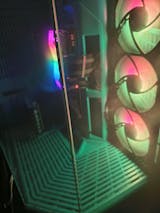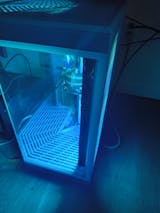Comparison between Gen 4 and Gen 5 Hard Drives, as well as SATA, with Special Attention to Gen 5's Copper Heatsinks

The Difference Between SATA SSDs of the Fourth and Fifth Generations
Speed and Capacity:
The fourth generation of NVMe SSDs, or "Gen 4" SSDs, are capable of blistering speeds. The PCIe 4.0 interface allows for speeds of up to 5,000 MB/s in reading and 4,400 MB/s in writing, making these drives perfect for resource-intensive activities like gaming and video editing.
Gen 5: The next generation of solid-state drives. The PCIe 5.0 interface allows for speeds of up to 8,000 MB/s in reading and 7,000 MB/s in writing, dramatically improving performance. Professionals dealing with enormous datasets or high-resolution media will find this to be very intriguing.
While SATA SSDs are quicker than HDDs, they are much slower than NVMe devices. Their maximum throughput of 600 MB/s is sometimes insufficient for data-intensive programs.
Capacity of Storage:
Storage capacity for Gen 4 and Gen 5 SSDs range from 256GB to several terabytes. Users with a wide range of storage requirements can benefit from these drives.
SATA solid-state drives (SSDs) also come in a variety of storage capacities, although they are typically much smaller than NVMe SSDs. NVMe is the best option if you require a large storage capacity.
Compatibility:
A PCIe 4.0 or PCIe 5.0 capable motherboard is necessary for a Gen 4 or Gen 5 SSD. Before buying, check to see if your computer has enough space for these disks.
However, SATA SSDs' universal compatibility is due to their usage of the standard SATA interface, which is present on both older and newer motherboards.
Generation 5 solid-state drives use copper for their heat sinks.
Gen 5 SSDs' improved performance comes at the cost of greater heat production. Because of the increased data transfer rates, the drive may overheat and become less reliable or efficient. In response, many companies producing Gen 5 SSDs have begun to incorporate copper heatsinks into their products.
So why do we need copper in our heat sinks?
Copper's high thermal conductivity makes it a popular material in the electronics industry. Copper's high heat-conducting properties make it ideal for use as a heatsink, keeping the SSD from becoming too hot and slowing down as a result. The main advantages of copper heatsinks in Gen 5 SSDs are as follows:
Copper heatsinks have superior cooling properties compared to the more common aluminum heatsinks. They contribute to keeping the SSD's temperature under control.
Enhanced Performance: Copper heatsinks eliminate the possibility of Gen 5 SSDs slowing down under heavy loads, allowing them to maintain their full stated transfer rates at all times.
A longer lifespan is achieved by keeping the SSD's operation temperature down. Since copper heatsinks prevent Gen 5 SSDs from overheating, they are crucial to the devices' longevity.
The SSD's fan doesn't have to work as hard to maintain a comfortable operating temperature, which translates to less audible system operation.
NVMe drives, and particularly Gen 5 SSDs, have shown themselves victorious in the continuing speed and performance duel between Gen 4, Gen 5, and SATA SSDs. Gen 5 SSDs can reach greater speeds, but they generate more heat as a result, making copper heatsinks an essential component. A attractive option for pros and enthusiasts alike, Gen 5 SSDs include copper heatsinks that efficiently dissipate heat to guarantee constant performance and endurance. You should think about the SSD's compatibility with your system, the performance you require, and the benefits of copper heatsinks for long-term durability before making your final decision.













